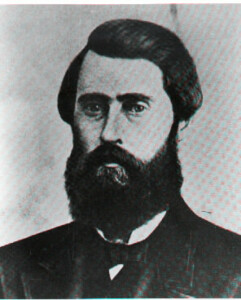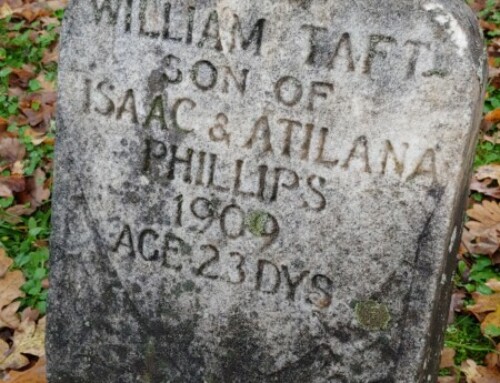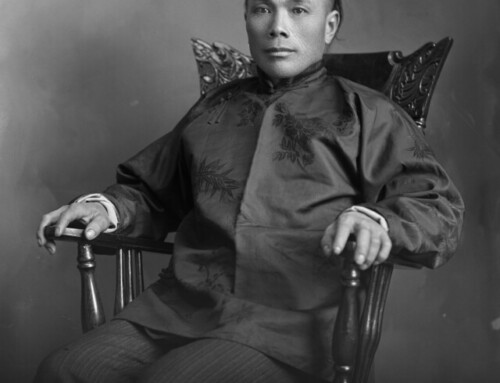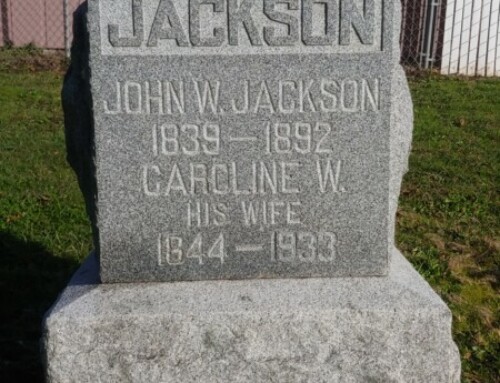Jason Lee
(1803-1845)

1840c. Head and Shoulder photo of Jason Lee at approx. age of 40 years. WHC Collections 1998.008.0007
In 1832, four Indians from the Flathead and Nez Perce tribes journeyed from their homelands in what is now northern Idaho and eastern Washington State to St. Louis, Missouri, where they met with Indian agent and former explorer General William Clark, and reportedly asked him for “the white man’s book of heaven.” They had heard from white trappers and other Indian tribes that the white men in the East possessed a book of great spiritual power, and wanted that power for their people. When the tale of the Indian’s pilgrimage reached the east coast, it immediately sparked the interest of evangelical Christian congregations. The Methodist Episcopal Church quickly formulated plans to establish a mission in the Pacific Northwest, and selected a young preacher named Jason Lee as its leader. Although Lee established his mission in what is now Salem, Oregon, hundreds of miles from the nearest Flathead or Nez Perce, and was almost entirely unsuccessful in his ministry to the local Kalapuya Indians, his mission had a dramatic and lasting effect that those four Indian searchers could never have anticipated. Lee founded not only a mission but a school (Willamette University) and a city (Salem). His work was instrumental in bringing settlers to the Willamette Valley, generating the “Oregon Fever” that would soon grip the nation, and establishing Oregon as a U. S. territory.
Jason Lee was born in 1803 in Stanstead, Quebec, just over the U.S.-Canada line from Vermont. He was the youngest of fifteen children, and his father died when he was only five years old. By the age of thirteen, Lee found himself “thrown upon the world, without money, to provide for all my wants,” as he later recalled. The 1810s and 20s, when Lee worked as a manual laborer, were a time of great religious fervor throughout the United States, when traveling preachers and revival meetings attracted huge crowds. It was at one of these revivals in 1826 that Lee first felt himself called to do the work of God. Despite his little previous education, Lee as accepted to the Wilbraham Academy in Massachusetts in 1829, where he trained to be a minister.
Over the course of his education, Lee came to believe that his calling in life was to live and labor among the Indians. When the Methodist Episcopal Church began planning a mission to the Flathead Indians, he was their emphatic choice for its leader. Lee selected his nephew, Daniel Lee, to be his assistant missionary, and Cyrus Shepard was appointed as lay missionary. With the addition of two other laymen, Philip Edwards and Courtney Walker, the small party prepared to cross the continent.
As residents of modern-day Oregon, it can be difficult for us to comprehend how isolated Oregon was in the 1830s, before the settlers of the 40s and 50s began pouring in. Although Lewis and Clark had explored the area in 1805-6, and the Hudson’s Bay Company was well established at the mouth of the Columbia River, the Willamette Valley was still almost exclusively populated by Native Americans, with a sprinkling of French-Canadian fur traders thrown in. On their overland journey, Lee’s party was led by Captain Nathaniel Wyeth, who had been to Oregon once before. His correspondence with Lee before the party set out hints at the great distance between Oregon and what was considered the “civilized world.” This distance was both physical and psychological. Wyeth wrote to Lee that, “A ship goes from London to the mouth of the Columbia river every year. A ship will go from Boston some time between this and next September. Occasional parties cross the mountains from and to the U. States.” In other words, the missionaries would be virtually cut off from the world they knew. They were literally journeying into the unknown.
Lee and his fellow missionaries arrived in the Willamette Valley in the fall of 1834. Encountering friendly Hudson’s Bay Company officials, fur traders eager to have a church and a school for their children, and Indians in apparent need of religious instruction, Lee decided to remain along the Willamette River rather than continuing up the Columbia to the Flathead lands. Because some members of the Chinook and other coastal tribes had flattened heads similar to the Flathead tribe, it is possible that Lee did not realize he was in the wrong place. In an area now known as Wheatland Ferry, ten miles north of Salem, they constructed a 32′ by 18′ mission building out of logs. The window sashes in the mission building were carved by Jason Lee with his jackknife. Today, Willamette Mission Park memorializes the original mission site.
In the spring of 1835, a school for Indian children was established with Cyrus Shepard as teacher. Three Kalapuya children had been taken in at the mission during the first winter, two of them orphans in poor health. However, this early success belies significant problems in the mission’s outreach to Indian children. Of the original three children taken in, the one healthy child soon ran away to rejoin his tribe. In the mission’s first year, an estimated fourteen children were taken in, of which five ran away, five died, and two died the following year. Twenty five children were received the following year, sixteen of which became ill. Because they had no natural immunities, Indians were extremely susceptible to European diseases, and smallpox, measles, diphtheria, malaria, and tuberculosis took a devastating toll. As early as 1842, Indians had almost disappeared from the Willamette Valley. The deaths of children at Lee’s mission made the local Indians wary of the missionaries, and caused many adults to avoid the mission altogether.
Despite these setbacks, Lee did not give up on his ministry to the Indians. He believed that in order for the mission to be a success, they needed to create a more stable community, including women and children. In response to Lee’s pleas for funds and reinforcements, the Board of Missions in New York sent the “First Reinforcement.” The group included Dr. Elijah White with his wife and two children; Alanson Beers, a blacksmith, with his wife and three children; and William H. Willson, a carpenter. It also included three unmarried women: Susan Downing, the fiancée of Cyrus Shepard; Elvira Johnson; and Anna Maria Pittman, whom the mission board chose in the hope that she would be a compatible wife for Lee. The reinforcements came via ship, around South America with a stopover in Hawaii, a voyage that took ten months. They arrived in May of 1837. Only two months later, on July 16th, in a beautiful fir grove east of the Mission house, Anna Maria and Jason Lee were joined in marriage, as were Cyrus Shepard and Susan Downing.
A second reinforcement arrived September 7, 1837, led by Reverend David Leslie. In March of 1838, Jason Lee left the mission in Leslie’s care and traveled east, returning to the United States with the hope of recruiting more missionaries. He brought with him a petition urging the U. S. to annex Oregon, signed by the ten men at the mission, 17 other American men, and nine French-Canadians who wished to be U. S. citizens. These 35 reportedly comprised three quarters of all white men in Oregon at that time.
Lee met with the mission board in New York and traveled up and down the east coast giving speeches to generate support for the mission and entice new settlers to come to Oregon, possibly hoping that increased American settlement there would encourage the government to make Oregon a U. S. territory. Lee was accompanied by one of the few Indian children he had managed to convert, a teenage boy whose religious devotion served as a testimonial to the mission’s success. Sadly, the boy died while in the east, far from his own people. Lee received more sad news while still in the East. His wife Anna Maria had died in childbirth on June 26, 1838, not quite a year after their wedding. In New York, a friend introduced Lee to Lucy Thompson, a recent graduate of the Newbury Seminary. After a brief courtship, they married in July 1839. That fall, Lee and his new wife sailed for Oregon on the Lausanne, along with fifty other new recruits for the mission. This group became known as the “Great Reinforcement.” Among them were five ordained ministers, including Reverend Gustavus Hines, and their families, as well as laymen including Lewis H. Judson and J. L. Parrish, with their wives and children.
Soon after the Great Reinforcement’s arrival on May 21, 1840, the missionaries constructed a mill on what would come to be known as Mill Creek, and appointed Rev. Hines as the head of a new Indian Manual Training School, to be constructed near the confluence of Mill Creek and the Willamette, an area that the Kalapuya called Chemeketa, meaning “place of peace.” In 1841, flooding at the main mission building prompted Lee to relocate the entire mission to Chemeketa, where a new residence was built in 1841. Known as Jason Lee House, it was located north of the Indian Manual Training School on what would become Broadway Street. A second building known as the Parsonage was built just south of the school, on land later occupied by the Kay Woolen Mill. Both buildings are now preserved on the grounds of Mission Mill Museum.
Meanwhile, increasing numbers of white settlers were arriving in the Willamette Valley, motivated by an 1839 bill that asserted U.S. ownership of Oregon and promised 1000 acres of land to every white male over 18. The land grant was reputedly Jason Lee’s idea. Lee believed that in order to transform Oregon into a Christian society, it was necessary to have established family life and strong civil government–in other words, large numbers of white settlers and U.S. territorial status. Although Lee did not give up his efforts towards the Indians, and sent people from his missionary to establish satellite missions in other areas of Oregon and Washington, the focus of the Chemeketa mission began to change, with less emphasis on converting the Indians and more on educating the children of white settlers. The Indian Manual training School evolved into the Oregon Institute, a school for white children, and was eventually renamed Willamette University. A new chapel was also built in 1843 to accommodate the growing number of settlers. This small chapel grew to be Salem’s First United Methodist Church. The same year, enough Americans had settled in Oregon that they easily outvoted the British and Canadians to create an American provisional government.
However, not everyone shared Lee’s vision for an Oregon filled with white, American, Christian settlers. Some of his fellow ministers disapproved of his leadership, and the mission board back east felt that he had abandoned the original goal of bringing God’s word to the Indians and was wasting money and manpower on a “colonization scheme.” In 1843, the board sent Reverend George Gary to replace Lee and restructure the mission. This bad news came while Lee was probably still mourning for his wife Lucy, who had died in March of 1842, only three weeks after giving birth to their daughter, Lucy Anna Maria. Leaving young Lucy in the care of Rev. and Mrs. Hines, Lee sailed for New York on Nov. 1, 1843, to defend his actions to the mission board.
After meeting with the board, Lee was exonerated of their most serious charge, misappropriating mission funds for land speculation, and his title of Missionary to Oregon was reinstated. However, he became ill while visiting friends and family in the East, and returned to his family home in Stanstead, Canada, where he died on March 12, 1845, at the age of 41.
In 1906, Jason Lee’s body was returned to Salem in recognition of his crucial role in the settlement of Oregon. His remains were re-interred in Lee Mission Cemetery beside those of his two wives. In 1954, Lee’s part in the development of the Pacific Northwest was recognized with a statue in the National Hall of Fame in Washington, D.C.
Researched and written by Sue Morrison and Katherine Wallig
Bibliography:
Bashford, James W. The Oregon Missions: the Story of how the Line was Run between Canada and the United States. New York: Abingdon Press, 1918.
Brosnan, Cornelius J. Jason Lee: Prophet of a New Oregon. New York: the Macmillan Co., 1930.
Canse, John M. Pilgrim and Pioneer: Dawn in the Northwest. New York: Abingdon Press, 1930.
Carey, Charles H. General History of Oregon Prior to 1861. Volume 1. Portland: Metropolitan Press, 1935.
Hines, H. K. Missionary History of the Pacific Northwest Containing the Wonderful Story of Jason Lee with Sketches of Many of His Co-Laborers, All Illustrating Life on the Plains and in the Mountains in Pioneer Days. Portland: H. K. Hines, 1899.
Maxwell, Ben. “Indians Notwithstanding, Jason Lee, Missionary, Had Mind to be Kind.” The Oregon Sunday Journal, Portland. 15 May 1938.
Terry, John. “Jason Lee’s Mission Perseveres in Valley’s Damp Drudgery.” Sunday Oregonian. 22 April 2001. Page A18.
Yarnes, T. D. The Contribution of Jason Lee to Civil Government in Oregon. Oregon Conference Historical Society. [no date] (Salem Public Library Hugh Morrow Pamphlet Collection)
This article originally appeared on the original Salem Online History site and has not been updated since 2006.








Leave A Comment